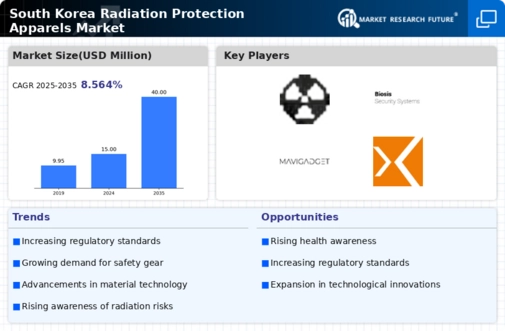The radiation protection-apparels market in South Korea is characterized by a competitive landscape that is increasingly shaped by innovation, strategic partnerships, and a focus on sustainability. Key players such as L3Harris Technologies (US), MarShield (CA), and Radiation Protection Products (US) are actively engaged in enhancing their product offerings and expanding their market presence. L3Harris Technologies (US) emphasizes technological advancements in its apparel designs, aiming to integrate smart technology for improved safety features. Meanwhile, MarShield (CA) focuses on regional expansion, particularly in Asia, to capitalize on the growing demand for radiation protection solutions. These strategies collectively foster a dynamic competitive environment, where companies are not only vying for market share but also striving to set new standards in safety and innovation.
In terms of business tactics, companies are increasingly localizing manufacturing to reduce lead times and enhance supply chain efficiency. The market structure appears moderately fragmented, with several players competing for dominance. This fragmentation allows for a diverse range of products and solutions, catering to various sectors, including healthcare and industrial applications. The collective influence of these key players is significant, as they drive advancements in technology and safety standards, thereby shaping consumer expectations and regulatory requirements.
In October 2025, L3Harris Technologies (US) announced a partnership with a leading South Korean healthcare provider to develop customized radiation protection apparel tailored for medical professionals. This strategic move is likely to enhance L3Harris's market penetration in South Korea, leveraging local expertise to create products that meet specific regulatory and operational needs. Such collaborations may also facilitate knowledge transfer and innovation, positioning the company favorably against competitors.
In September 2025, MarShield (CA) launched a new line of eco-friendly radiation protection garments, utilizing sustainable materials. This initiative not only aligns with global sustainability trends but also addresses the increasing consumer demand for environmentally responsible products. By prioritizing sustainability, MarShield (CA) differentiates itself in a crowded market, potentially attracting a new segment of environmentally conscious customers.
In August 2025, Radiation Protection Products (US) expanded its distribution network in South Korea by partnering with local suppliers. This strategic action is indicative of a broader trend towards optimizing supply chains and enhancing product availability. By establishing local partnerships, the company can respond more swiftly to market demands and improve customer service, which is crucial in a competitive landscape where responsiveness is key.
As of November 2025, the competitive trends in the radiation protection-apparels market are increasingly defined by digitalization, sustainability, and the integration of advanced technologies such as AI. Strategic alliances are becoming more prevalent, as companies recognize the value of collaboration in driving innovation and enhancing product offerings. Looking ahead, competitive differentiation is likely to evolve from traditional price-based competition to a focus on technological innovation, sustainability, and supply chain reliability. This shift suggests that companies that can effectively leverage these trends will be better positioned to thrive in the evolving market landscape.















Leave a Comment